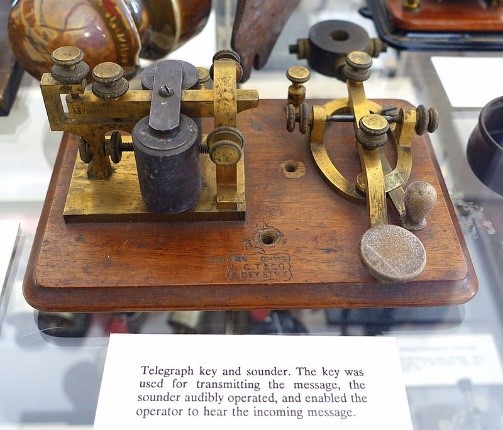Technology has become integrated into almost every aspect of our lives and cyber security is essential for our protection against threats. These days, we’re all familiar with things such as viruses, phishing, hackers, fraud, data breaches, and many other online dangers. What you may not know is that cybercrime has been around longer than computers have existed.
The History of Cybercrime
1834 – In the broad sense of the term, cybercrime goes as far back as the 19th century. In 1834 the French Telegraph System was hacked by two brothers who were bankers. François and Joseph Blanc bribed telegraph operators to send stock exchange information to an accomplice of the brothers’.
Their scheme involved inserting intentional errors into telegraph messages. These were codes relating to financial market information. The Blanc brothers kept their wire fraud operation running undiscovered for two years, essentially committing the first cyber-attack.

1903 – The late 19th century also saw the discovery of electromagnets waves. This led to the invention of Guglielmo Marconi’s wireless telegraph and, shortly thereafter, a notorious hacking exploit. In 1903, John Ambrose Fleming conducted the first public demonstration of Marconi’s invention, which claimed to be highly secure wireless telegraphy technology.
During the presentation, the device’s message was interrupted by Nevil Maskelyne, a magician and inventor. Maskelyne claimed that his reason for disrupting the show with insulting Morse code messages was to reveal the security issues posed by Marconi’s device.
1940 – The first recorded instance of ethical hacking took place in 1940 at the hands of a devoted member of the French Resistance during World War II. Rene Carmille was a punch-card computer expert and owner in Nazi-occupied France who used his skills and knowledge to fight back. He discovered that the Nazis were using the information captured by punch-card machines to hunt down Jews during the census.
Not only did his Resistance group significantly delay this process by mishandling punch cards, but Carmille took things even further. He offered the Nazis the use of his machines and then reprogrammed them to never punch information relating to religion onto census cards. His actions literally saved tens of thousands of Jews from being sent to death camps.
1957 – Before computer hacking, there was phone phreaking. Phreaking is a slang term meaning the manipulation of a telephone system. Most commonly, phreaks illegally hack into telephone networks to tap phone lines or make long-distance calls for free. Josef Engressia, AKA Joybubbles, is cited as being the very first phone phreak in the US. Born blind, but with perfect pitch, Josef was only 7 years old when he accidentally discovered his talent. Fascinated with telephones, he mimicked the operator tones which activated phone switches. This enabled him to place free calls simply by whistling the correct frequency into any telephone.

1971 – Steve Wozniak and Steve Jobs are best known for being the founders of Apple. But telephone hacking was the seed that eventually sprouted into the modern computer empire. Wozniak read an article about Joybubbles and became so intrigued by phreaking that he learned how to hack from John Draper (aka Captain Crunch).
When he had the art of phreaking mastered, Wozniak created a device called the blue box. This was specifically designed and built to make hacking into phone systems easy. His friend, Steve Jobs, realized that the invention had the potential for more than prank-calling the Pope. The pair began producing and selling blue boxes to their classmates – an enterprise that grew into Apple Inc.
1988 – Computer viruses are a common tool used by cybercriminals and one of the leading threats to cyber security. It was in 1988 that the first computer worm was distributed via the internet – by accident. The perpetrator was Robert Morris, who launched it from the MIT computer systems. Morris claimed that his intentions were only to gauge the size of the internet and highlight security flaws.
The supposedly harmless experiment turned into an attack because of a bug in the worm. The bug enabled the worm to infect a computer numerous times and each time would result in the system being further compromised until it was rendered unstable. The internet had to be partitioned for days while the devastation caused by the worm was rectified. Morris has the dubious honour of being the first cybercriminal to be tried and convicted by a jury under the Computer Fraud and Abuse Act.

2008 – Anonymous is a hacktivist group that enjoys global notoriety for its revolutionary actions against organisations it believes to be corrupt. Project Chanology was the name given to a series of attacks and protests against the Church of Scientology in 2008.
Anonymous targeted the organisation’s website with 500 denial-of-service attacks in only one week. The motivation for the attack was cited to be in defence of free speech after the church had a leaked video removed from YouTube.
2020 – In April 2020, it was reported that the personal information of around 267 million Facebook users was listed for sale on the Dark Web. The surprising price tag on this compromised data was supposedly only a little over £400.
Fortunately, no passwords appeared in the bundle, but it did include names, birth dates, email addresses, phone numbers, and Facebook IDs. This isn’t the first time in recent history that Facebook has suffered a serious privacy breach and it seems that the social media site is a prime target for cybercriminals.
As long as the internet exists, so will cybercrime. Cyber security professionals fight cybercrime daily and cyber security trends show an ever-increasing demand for new heroes.
If you want to be a cyber security superhero, your first step is to complete the relevant cyber security training. This will ensure that you’re well equipped for a cyber security job and have what it takes to protect people and organisations against these threats. Your future as a defender against cybercrime starts here.


Recent Comments